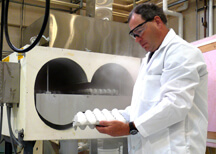Rapidly cooling eggs can double shelf life, decrease risk of illness
June 11, 2012
 |
|
Kevin Keener developed a rapid egg cooling system that uses circulated carbon dioxide to create a thin layer of ice inside an egg's shell that cools the inside of an egg within minutes, strengthening proteins and increasing shelf life. (Purdue Agricultural Communication file photo/Keith Robinson) |
WEST LAFAYETTE, Ind. – Taking just a few seconds to cool freshly laid eggs would add weeks to their shelf life, according to a Purdue University study.
The rapid-cooling process, developed by Kevin Keener, a professor of food science, uses liquid carbon dioxide to stabilize the proteins in egg whites so much that they could be rated AA – the highest grade for eggs – for 12 weeks. Earlier research showed that the same cooling technology could significantly reduce occurrences of salmonella illnesses.
Eggs cooled under current methods lose the AA grade in about six weeks, Keener said.
"There is no statistical difference in quality between eggs as measured by Haugh units just after laying and rapidly cooled eggs at 12 weeks," he said. "This rapid-cooling process can provide a significant extension in the shelf life of eggs compared to traditional processing."
Haugh units measure an egg white's protein quality.
Keener's results, published in the journal Poultry Science, also show that membranes surrounding the eggs' yolks were maintained for 12 weeks when eggs were rapidly cooled. That membrane is a barrier that keeps harmful bacteria from reaching the yolk, a nutrient-rich reservoir that bacteria could use as a food source.
"The structural integrity of the yolk membrane stays strong longer, which may provide a food safety benefit," he said. "The membrane being stronger would be another defense against bacterial invasion, such as salmonella."
The rapid-cooling technology takes liquid carbon dioxide and turns it into a "snow" to rapidly lower the eggs' temperature. Eggs are placed in a cooling chamber and carbon dioxide gas at about minus 110 degrees Fahrenheit is generated. The cold gas is circulated around the eggs and forms a thin layer of ice inside the eggshell. After treatment, the ice layer melts and quickly lowers an egg's internal temperature to below 45 degrees, the temperature at which salmonella can no longer grow.
Keener's previous research showed that the carbon dioxide in bicarbonate form significantly increases the activity of lysozyme, an enzyme in the egg white that has bactericidal properties.
Traditionally, eggs are at more than 100 degrees when placed into a carton. Thirty dozen eggs are then packed in a case, and 30 cases are stacked onto pallets and placed in refrigerated coolers. The eggs in the middle of the pallet can take up to 142 hours - nearly six days - to cool to 45 degrees, Keener said.
Keener said a 2005 U.S. government report showed that if eggs were cooled and stored at 45 degrees within 12 hours of laying, there would be about 100,000 fewer salmonella illnesses from eggs in the nation each year.
Rapid cooling could also increase the ability to export eggs to places where this isn't possible today.
"You could send eggs anywhere in the world if you could get even eight weeks of shelf life at AA quality. We're seeing 12 weeks," Keener said. "Right now, you can't ship eggs anywhere in the world and expect to retain that quality."
Keener said with additional funding he would continue to study the benefits of rapid cooling, including inoculating the inside of shell eggs with Salmonella and examining how other proteins in the whites and yolks of eggs are affected.
Keener is a technical consultant to the American Egg Board and a member of the United Egg Producers Scientific Advisory Panel. His work was funded by Purdue and gift funds.
Writer: Brian Wallheimer, 765-496-2050, bwallhei@purdue.edu
Source: Kevin Keener, 765-494-6648, kkeener@purdue.edu
ABSTRACT
Maximizing Carbon Dioxide Content of Shell Eggs by Rapid Cooling Treatment and Its Effect on Shell Egg Quality
P. Banerjee and K.M. Keener
Rapid cooling of shell eggs using liquid CO2 has been shown to cool eggs to 7°C within minutes, as opposed to days required by traditional cooling treatments. This quick-cooling technique is component in the maintenance of egg quality and extended shelf life beyond the current 30-45-d period. The hypothesis for the current study was that maximizing CO2 content of the eggs during cooling may increase Haugh units and thus extend shelf life (physical quality factors). The objective of this study was to maximize CO2 content of shell eggs during rapid cooling with liquid CO2 and determine its effect on egg quality during 12 wk of refrigerated storage. Three cooling conditions selected for the study were −45°C for 18 min (treatment A), −60°C for 15 min (treatment B), and −75°C for 12 min (treatment C). After rapid-cooling treatment, it took approximately 25 min for the internal temperature of eggs to equilibrate to 7°C. The Haugh units of the rapidly cooled eggs were significantly higher than the traditionally cooled (control) eggs. After 12 wk of refrigerated (5–7°C) storage, control eggs were only 37% AA-grade, 57% A-grade, and 6% B-grade. In comparison, all the rapidly cooled eggs averaged to 80% AA-grade and 20% A-grade. After 6 wk, the average quality of control eggs reduced to grade A, whereas rapid cooling treatment was able to maintain AA quality up to 12 wk. The CO2 content of the rapidly cooled eggs (1.8 mg of CO2/g of albumen) showed no difference between treatments A, B, and C, but it was significantly higher than the control (1.3 mg of CO2/g of albumen). In addition, the vitelline membrane strength of the control decreased 65% during storage and was between 30 and 50% of the vitelline membrane strength of CO2-cooled eggs at 12 wk. Rapid cooling with liquid CO2 extends shelf life of shell eggs.
Ag Communications: (765) 494-2722;
Keith Robinson, robins89@purdue.edu
Agriculture News Page

